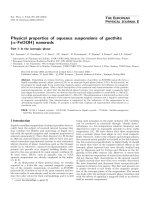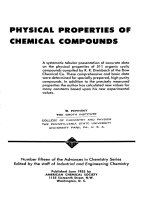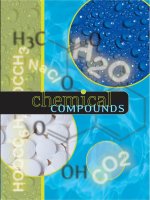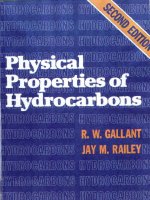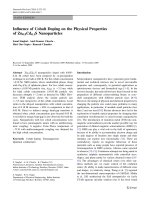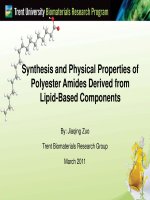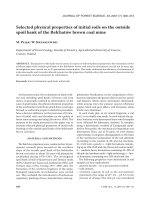physical properties of chemical compounds
Bạn đang xem bản rút gọn của tài liệu. Xem và tải ngay bản đầy đủ của tài liệu tại đây (15.21 MB, 535 trang )
PHYSICAL PROPERTIES OF
PHYSICAL PROPERTIES OF
Published on January 1, 1961 on | doi: 10.1021/ba-1955-0015.fw001
CHEMICAL COMPOUNDS
CHEMICAL COMPOUNDS
A systematic tabular presentation of accurate data
A
on the physical properties of 511 organic cyclic
Dow
compounds compiled by R. R. Dreisbach of the Dow
Chemical Co. These comprehensive and basic data
were determined for specially prepared, high purity
prepared,
compounds. In addition to the precisely measured
properties the author has calculated new values for
many constants based upon his new experimental
values.
R.
PEPINSKY
THE GROTH INSTITUT~
COLL~GE OF CHEMISTRY AND PHYSICS
THE: PENNSYLVANIA STATE UNIVERSITY
UNIVERSITY PARr.. PA .• U. S. A.
Number fifteen of the Advances in Chemistry Series
Number fifteen of the Advances in Chemistry Series
Edited by the staff of Industrial and Engineering Chemistry
Edited b y the staff of Industrial and Engineering
Published June 1955 by
P u b l i s h e d J u n e 1955 b y
AMERICAN CHEMICAL SOCIETY
A M E R I C A N C H E M I C A L SOCIETY
1155
N.W.
1155 Sixteenth Street, N.W.
Washington, D. C.
Washington,
Published on January 1, 1961 on | doi: 10.1021/ba-1955-0015.fw001
Copyright 1955 by
1955 by
AIIERlcAN CHEMICAL SOCIETY
AMERICAN CHEMICAL SoCIETY
All RightsRuerv«l
AU Rightll Reserved
Physical Properties
Published on January 1, 1961 on | doi: 10.1021/ba-1955-0015.ch001
Of Chemical Compounds
R. R. Dreisbach
The Dow Chemical Co., Midland, Mich.
Definition of the Symbols and Parameters Used, with the
Methods of Calculating the Parameters
% Pur.: Mole % purity by weight.
F.P.! Freezing point, ° C.
Mol.
F.P. 100%: Freezing point curve extrapolated to 100% purity.
B.P. 760 mm., 100 mm., etc.: Boiling points at these pressures, ° C.
Pn : Pressures at 25° C., in mm.
P.: Pressure corresponding to temperature t. in mm.
d 20, etc.: Density at 20° C., etc., g./ml.
a, b: Constants of Law of Rectilinear Diameters, dv + dL = a + bt
d. = density of the vapor, g./ml.; dL = density of the liquid, g./ml.
ng', etc.: Refractive index for the sodium line at 20° C., etc.
+ 0.4)
l)/(nfi + 2) X
"c"
"C": Constant of the Eykman equation, (nfi - 1)/(no
X l/d =
MR (obs.): Molal refraction (obs.) = (nfi (M = mol. wt.)
M/d = MR at 20° C.
MR (calc.): Molal refraction calculated from atomic refractive indices. See page 9.
3
ADVANCES IN CHEMISTRY SERIES
(nu - d/2): Refractivity intercept equals refractive index minus one half the density,
both at the same temperature, 20° C.
D: Dielectric constant run at a frequency of 1()6 (cycles/sec.) and at 25° C. unless otherwise noted. When reported as data of The Dow Chemical Co., error about
±0.005. Where Reference 5 is noted it was obtained by squaring the refractive
index at 20° C.
Published on January 1, 1961 on | doi: 10.1021/ba-1955-0015.ch001
A, B, C: Constants of the Antoine vapor pressure equation for the liquid state, giving P
(pressure) in mm. and t (temperature) in ° C. This is in the range between the
temperatures as indicated. These temperatures in general are the boiling point at
30 mm. to a TR of 0.75 to 0.80. See method of obtaining A, B, C on page 6.
Antoine equation: log P = A - B/(t + C)
A·, B*, K, c, tk, tx: Constants of the saturated vapor density equation
log dy(g./ml.) = A* - B·/(t + C) to the temperature tk
log dy(g./ml.) = A· - B·/(t + C) + K/(1.1 Tc - 273.2 - t) + c
from temperature h to a reduced temperature, Ta, of 0.92
tk = Temperature at which it is necessary to change from the simple vapor density
equation to the corrected vapor density equation in the higher ranges, ° C.
tk = tx + K/c and tx = (1.1 Tc - 273.2)° C.
A* and B· where the ls.tent heat at the atmospheric boiling point is available.
Vg - VL = (31381.7 X .1Hv X dt/dp)/T
Where the ls.tent heat is not avails.ble use
M(.1Hv)/TB = 21.0 and from this .1Hv = (TB X 21.0)/M
The value 21.0 (or any other value as 21.4 say) is obtained from the nearest rels.ted
compound which has a latent heat available. Then proceed as in case where ls.tent
heat is avails.ble for Vg value at B.P.
Since d. = l/Vg
log dY710 = A· - B·/(ta + C) at 760 mm.
log dY30 = A· - B·/(tao + C) at 30 mm.
Solve for A·, B·, since t and d. at 760 mm. and 30 mm. and C are known.
A', B/, C / : Constants of the Antoine vapor pressure equation below 30 mm. pressure,
covering the temperature range as indicated. See method of obtaining the constants
on page 6.
A'·, B/*: Constants of the vapor density equation below 30 mm. These two values are
obtained by using the boiling point at 30 mm. and the pressure at 25° C. (obtained
from the values A', B I, C ') and assuming that at 25 0 C. the rels.tionship PV/RT
= 1. Then we have Vg at 25° C. = RT/MP = 62,361 X (25 + 273.2)/MP.
Then dv = I/Vg. Inserting these values of vapor density we then solve the two
equations for the values of A'· and B /• as in the case of A· and B·.
Ac, Bc, Cc: Constants of the Antoine vapor pressure equation for the liquid state from
Ta = 0.75 (or a higher Ta as indicated) to the critical temperature. See method of
obtaining the constants on page 7.
Cryoscopic Constants, A 0, BO: Cryoscopic constants for calculs.ting mole % purity.
See J. Research Nall. Bur. Standards, 35 (1945); RP 1676.
PHYSICAL PROPERTIES OF CHEMICAL COMPOUNDS
5
t.O C.: Temperature at which a mole of the vapor occupies 22.414 liters and the vapor is in
equilibrium with the liquid, in 0 C.
te=
B*
-C
(A * - log dvo)
Published on January 1, 1961 on | doi: 10.1021/ba-1955-0015.ch001
dt/dp: Rate of change of boiling point with pressure, given by equation dt/dp = B/
[2.3026 X P X (A - log P)2Jo C./mm.
~Hm: Latent heat of fusion in caL/g.
~Hv: Latent heat of vaporization at the temperature designated, caL/g.
t.(d, e): The latent heat of vaporization at the temperature to as given by the equation
~Hv = d - et, and indicates the accuracy of thiR equation at the temperature t •.
~Hv/T.:
~Iolal latent heat of vaporization at t. divided by To. (Equal to the molal
entropy of vaporization at te.)
d, e; d', e': These are parameters of the latent heat of vaporization equation, ~Hv
(caL/g.) = d - et. This is valid between the temperatures indicated. It has been
found that the latent heat between the boiling point at 30 mm. and the boiling point
at i60 mOl. is almost a linear function of the temperature. As seen in most cases
this equation holds almost to the temperature te. Above and below this the latent
heat is not linear with temperature except for short intervals.
d.: Critical density, g./mL
v.: Critical volume, ml./g.
to: Critical temperature, ° C. See also page 7.
P. mm.: Critical pressure in mill. Whel'e this was not obtained from the literature it is
calculated as follows (The Thomson method, private communication from George
W. Thomson): The critical temperature is inserted in the Antoine equation, using
the A, B, and C values to calculate the critical pressure.
This value is too low. This is then multiplied by 1.07 and is assumed to be the
critical pressure. In the great majority of cases, this will agree with determined
values to within ±3%. For high boiling compounds this value must be decreased,
since in most cases there is somewhat irl'egular drift with increasing temperature,
so this should be continually lowered as the boiling point becomes increasingly
higher.
PV/RT: Compressibility at the temperature designated.
z = PV/RT
where P = pressure in mill., V = volume in mL/mole, and R = 62361.
~Hc: Heat of combustion, kcaL/mole, gas at constant pressure, 298.16 0 K. or 25 0 C.
~Hf: Heat of formation, kcaL/mole, liquid at 298.16° K. or 25 0 C.
~Ff: Free energy of fOlnlation, kcal./mole, liquid at 298.16° K. or 25° C.
,,: Kinematic viscosity in centistokes, at temperature designated. The kinematic viscosity is given by the equation
log" = A" + B'/T
between the temperatures indicated to an accuracy of 1% or better.
HoP. °c., 30mm.; dt/dp; ~H,'; PV /RT: These ,'aluesat30mm. are calculated from the
Antoine equation using A, B, lind C. It has been found that at 30 mOl. in almost all
Cox ChaIt Families the ratio PY /RT is negligibly different from one. This, then,
has been taken as olle point (the other point being the B.P. at 760 mm.) from which
to calculate A* and B*, always assuming the compressibility as 1.0000 at 30 mm.
Published on January 1, 1961 on | doi: 10.1021/ba-1955-0015.ch001
6
ADVANaS IN CHEMISTRY SHIES
cp: Specific heat at constant pressure at temperature designated, cal./g. 0 K.
Cy: Specific heat at constant volume at temperature designated, cal./g. 0 K.
f, g, h, f', g', h': Parameters of the heat content equation for the liquid for the temperature ranges designated, 0 K.
Cp (liquid) = f + gT + hTI
m, n, 0, m', n', 0': Parameters of the heat content equation for the vapor for the temperature ranges designated, 0 K.
Cp (vapor) = m + nT + oTt
'Y: Surface tension in dynes/cm., at temperature designated.
[PI: Parachor at the temperature designated:
M('Y)'/'/(dL - dy) = [PI
[PI Sugd.: Parachor from atomic and structural values &8 given by Sugden. See Table.
The parachor value for oxygen &8 hydroxyl (alcohols) in these tables is taken &8 15.
Sugden gives the values of 20 for oxygen and 30 for oxygen in esters, which does not
seem to work for alcohols and phenols.
Exp. L.l.; Exp. L.u.: Explosion limits lower and upper range, % by wt.
Dispersion: Specific dispersion, 104(nr - nc)/d, ml./g. at 25 0 c.
nr, nc = refractive index for F and Clines.
d = density, g./ml.
Flash and Fire Points, 0 C.: Cleveland open cup (ASTM D 92-46) if not otherwise designated. Closed cup (ASTM D 56-36) will be designated &8 such.
M Spec.: Mass Spectrograph.
Ultra V.: Ultraviolet.
X-Ray Dif.: X-Ray Diffraction.
Infrared: Infrared Spectrograph.
Solubility at 25 0 C., in solvents as designated.
Ezplanation of the methods used for calculating the variom parameter. in the foregoing:
A, B, C: The A, B, and C constants, except where given by the API reports, are calculated by means of the Thomson method [Chem. Rev•. , 38, 1-39 (1946)] using the
determined boiling points at three different pressures. The three formulas for this
are &8 follows:
(y, - YI)/(YI - YI)·(tt - tM(t. - tt) =·1 - (t. - tl)/(t. + C)
B = (Ya - YI)/(tt - tl)·(tl + C)(ta + C) and
A = YI + B/(tl + C)
where Yh Y2, and y, are equal to log PI, log P"~ and log Paat temperatures t l, t " and ta.
Unless the data for the three points are very accurate the C value can be considerably
in error. As a check on this method an empirical formula developed by Thomson
(private communication from George W. Thomson) will give a much better value of
C if the data are much in error. This formula is C = 239 - 0.19b. The A and B
values can then be readily determined from the two points given, since they are much
less critical.
A', B', C' (for pressures below 30 mm.): Applicable when molar heats of vaporization are
available at 25 0 C. and the Antoine equation can be used to obtain the boiling point
at 30 mm. Let A, B, C be the constants of the usual Antoine equation valid above
30 mm. and let A', B', C' be the constants of the Antoine equation 8Oughtforbelow
30 mm. These two equations are taken to give the same value of the p~ure
temperature slope at 30 mm.
log 30 = A - B/(tl + C) = A' - B'/(tl + C')
B/(t ,
C)' = B'/(tl + C')2
+
7
PHYSICAL PROPERTIES OF CHEMICAL COMPOUNDS
Since PV/RT may be assumed to be 1.0000 at th the temperature corresponding to
30 mm., and is also 1.0000 at 25° C., the molar heat of vaporization at 25° C.,
M~Hv2, is given by
M~Hv2 = 2.3026 RB' l(t2 + 273.2)/(t2 + C'»)2
where t2 = 25° C. To solve for A', B', C' let
g2 = M~Hv2l2.3026 R(t2 + 273.2)2 = M.1Hv2l406883 if t2 = 25 C.
Also g2 = B'/(t2 + C')2
Published on January 1, 1961 on | doi: 10.1021/ba-1955-0015.ch001
0
Since th t2 and all values on left hand side of equations above are known then B' and
C' are readily obtained as follows:
[B'j(t! + C')2)[(tl + C')2/B') = g2 (tl + C'>,/B' = say, h 2
Then C' = (tl - ht2
)/(h - 1) and B' = g2(t 2 + C')2
Also B' = B[(tl + C')/(tl + C»)2
A' = log 30 + B'/(t. + C') since PI = 30 mm.
These formulas were developed with the aid of George Thomson.
When heal8 of vaporization at 25° C. are not knoum:
In this case the C' value is estimated and A' and B' are calculated from known data.
It was noticed that C' has a value approximately 18 higher than C when latent heats
at 25° C. are known. By adding this increment to C we have C', thenB' from the
relation for the first case
B' = B [(t30 + C')/(t3o + C»)2
and then A' as in first case.
Ac, Bc, Cc: This method was developed by George Thomson [Chern. Re1J8., 38,
No.1, 23 (1946)] and is similar to the one for obtaining A', B', C'. It is assumed
that the parameters A, B, C of the Antoine equation are good to a T. 0.75 or a
higher reduced temperature, and this temperature corresponds to the 25° C. in the
case of A', B', C', and the critical point corresponds to the 30 mm. point.
B/(tl + C)2.(t. - tl)/(y. - YI) = 1 + (to - tl)/(tl + Cc)
and Bc = (y. - YI)/(t. - t.)·(tl + Cc)(t. + Cc); Ac = B/(t. + Cc) + y.
where tl ° C. = T. 0.75, t. 0 C. = critical temperature
YI = log P at t l, y. = log P.
The first equation is used to evaluate Cc, the lrecond, Bc, and the third, Ac.
As.qociation: The association in the vapor phase of organic acids seems to vary inversely
as the temperature fOJ some acids, at least for part of the range. In part of the range,
and also apparently for some acids over the whole range, the association is fairly constant. The association is given in these sheets by the formula ME = P - rt. For
instance, for acetic acid this formula would be ME = 2.225 - 0.004085 t from 0° C. to
100° C. From 100° C. to a T. of 0.92, ME = 1.85. That is to say, the vapor density
as calculated by the A *, B* formula would have to be multiplied by this correction
factor to take care of the association. Further, if the reciprocal of the density is used
as calculated to give vapor volume, it would be necessary to divide by 1.85 to get
the actual vapor volume.
t.: Where the critical temperature has not been determined, it is calculated by Watson's
equation:
T./T, = 0.283(M/d.)o.18
where d. = liquid density, g./ml. at the boiling point, and M = molecular weight.
This is used for ull hydrocarbons and halohydrocarbons.
ADVANCES IN CHEMISTRY SERIES
8
f, g, h, m, n, 0, etc.: For a short temperature range the equation Cp = f + gT + hTI
reproduces almost exactly determined data. The parameters were set up on the
IBM machines using eight determined values where that many or more were
available.
Published on January 1, 1961 on | doi: 10.1021/ba-1955-0015.ch001
The IB~I machines were used to set up the Antoine con8tants from determined data.
A preliminary C value was obtained from the equation C = 239. - O.19ta. A and B
were then obtained and new C values either side of the first C used and new A and B
values found. In each case above, the boiling points at the experimental pressures
were calculated and compared with the determined boiling points.
Actually the value of C was generally obtained from C = 239. - O.19ta, since the
determined values must be very very accurate to give better values of C.
Cox Chart Famllie.
1. Alkyl and halo benzene"
2. Styrenes
:J. Thiaalkyl benzenes
4. Thiophenes
5. Alkyl naphthalenes
6. Tetrahydronaphthalenes
i.
Decahydronaphthalene~
Aromatic phenols
Thiophenols
Aromatic amine"
11. N itrobenzenf'll
8.
9.
10.
12.
13.
14.
15.
16.
Ii.
18.
19.
20.
21.
22.
Aromatic alcohols (Phenyl ethyl alcohols)
Aromatic ketones
Aromatic esters
Cyclopentanes
Cyclopentenes
Thiacyclopentanes
Thiacyclopropanes
Cyclohexancs
Cyclohexenep
Thiacyclohexanes
Miscellaneous
PHYSICAL PROPERnES Of CHEMICAL COMPOUNDS
9
Atomic Refractive Indices Used for Computing Molecular Refractive Index
Published on January 1, 1961 on | doi: 10.1021/ba-1955-0015.ch001
All values are for the sodium line.
Carbon singly bound and alone
Carbon singly bound
Carbon double bond
Carbon triple bond
Carbon conjugated
Hydrogen
Oxygen-hydroxyl
Oxygen-ethereal
Oxygen-ketonic
Oxygen-as ester
2.592
2.418
l.733
2.398
1.27
1.100
1.525
1.643
2.211
1.64
Sulfur-as SH
Sulfur-as RSR
Sulfur-as RCNS
Sulfur-as RSSR
Nitrogen
as aliphatic primary amine
as aromatic primary amine
as aliphatic secondary amine
as aromatic secondary amine
as aliphatic tertiary amine
as aromatic tertiary amine
as hydroxylamine
as hydrazine
as aliphatic cyanide
as aromatic cyanide
as aliphatic oxime
as primary amide
as secondary amide
as tertiary amide
7.69
7.97
7.91
8.11
NO as nitrites
NO as nitrosoamine
NO. as alkyl nitrite
NO. as alkyl nitrate
NO. as nitro paraffin
NO. as nitro aromatic
NO. as nitramine
Fluorine
Chlorine
Bromine
Iodine
5.91
5.37
7.44
7.59
6:72
7.30
7.51
0.955.967
8.865
13.900
2.45
3.21
2.65
3.59
3.00
4.36
2.48
2.47
3.05
3.79
3.93
2.65
2.27
2.71
• This value for one fluorine atom attached to carbon. The value 1.1 is to be used for each
fluorine atom in polyfluorides.
Atomic and Structural Constants for Calculation of Parachor
CH.....................
C.................. .....
H ......................
0 ......................
o (Alcohol)...... . . . . . . . .
O.(Ester).. .. . . . . . . . . . ..
N......................
N (Nitrile). . . . . . . . . . . . ..
S .......................
F .......................
Cl..... . . . . .. .. .. . . . . . ..
Sugden
39.0
4.8
17.1
20.0
15.0
60.0
12.5
14.4
48.2
25.7
54.3
Sugden
Br...................... 68.0
I.. . . . . . . . . . . . . . . . . . . . .. 91.0
Single bond ............. .
Double bond. . . . . . . . . . . .. 23 . 2
Triple bond. . . . . . . . . . . . .. 46.6
3-Membered ring.... . . . .. 16.7
4-Membered ring......... 11.6
5-Membered ring.... . . . . . 8.5
6-Membered ring.... . . . . . 6.1
7-Membered ring ........ .
Aliphatic alcohol. .. subtract 6.0
Published on January 1, 1961 on | doi: 10.1021/ba-1955-0015.ch001
TABLE I.
ALKYL AND HALO BENZENES
No
I
I
NAME
Benzene
Mole
1RefJ Molecular
"Pur. 99.9961 z'l Formula
C 6H 6
B.;fr; ·C
100 mm
Molecular
W.,,-ht 78. 108
Published on January 1, 1961 on | doi: 10.1021/ba-1955-0015.ch001
~~
Ref
Z
dt/dP
f
I
·C/mm
80.100
Z6.075
_I~: ~O
o
I
R.f
5.533
F P ·C
F. P. 100'10
I
STRUCTURAL FORMULA
Z5·C
BP
te
Z
Z
:
5
Z
5
Ref. Inde,.
nO ZO·C
Z5
30
I. SOliZ
1.4979Z
1. 49468
0.7500
MR (Ob •• )
MR (Calc.)
::!
1
4
to
1_- _.~
Z
Z
Dielectric
Z.Z83
A I 0 to
6.90565
B 1.l.6.Q. :"C_ IZ11. 033
C
ZZO.79
I
Z
Z
Z
.1
A·, IS to
1.19411
B.l!5,!..·£. 11 Z7. 9
K
Z5.0
c
-0.13147
tk fT50to ISS.
~ IZ45·C
345.8
~I
~
B'I _ _ o£.
C'
A'.
B'.
to
·C
AclI60
BCLtc
Cc
Cryos.
con.t ••
to
·C
A·
B·
PV IRT
ZS·C
30mm
BP
t.
tc
6Hc kcal/m
6W
4
6Ff
4
4
Visco.ity
4
centistoke.
4."
ZO·C
5
30
50
70
B V 1 Z5 to
A v I 80 ·C
1-(B"iI - to-
~~--~+-------+-~I
7. 4Z91Z
16Z8.3Z
Z79.56
0.015Z3
0.003Z
te ·C
88.04
TR = O.77Tc
REFERENCES:
SOURCE:
PURIFICATION:
I-Dow
t
lI...:e!:':"LI--=-Z~5~.~C:.+_~0.:..!Z:..!0~8~8~":5~1r.~=:;:::-,;4;;;01t-'Z:..:6",..:;1..:;4-rZ~
•
Z I~
Z
d c Ilml
Vc mill
4
t.C
c
4
Pc mm
z6.1835
1.0616Z
(nD-d/Z)
0.5949
30.09
I
4
4
0.0669
I
I
h
f'
R.f
O. Z605
0.0 3 31
4
Z I--=-L""""'T----I----I---l
~--~1----~~-4~5~.----~5~1~~~~~1_~~~--r_~ m
1 300to -0.1030 4
6Hv calli
I
Pre •• ure
Z5·C
103.57
Z
n I
_ IQO....:~ 0.0014 4
mm Z5·C
9S.18
5
-0.0 6 71 4
30mm
108.19
4
0
1
964.4
5
t.
BP
94.14
Z
m'l
Density
te
9Z.65
5
n' I
Ilml ZO"C
0.87901
Z
te (d, e)
91.71
5
0' I
dt
Z5
0.87370 Z
6Hv/Te
ZO.03
5
4
30
0.86837 4
Surface tenoion
a
0.900Z5 4
::
~!~ 10~:~~1l ~ dynes/cm. ZOOC Z8.88 Z
+--=:-0::.;.:..:0:..:0~1.:.05::..j....:4!.....1I-d.,- 0 to
108.79
5.
30
Z7.49
Z
r-:b=--___
30 mm
6Hm calli
O. ZZ76
0.04Z71
0.0355
I
5
5
5
Z
Z
0.300
3.333
Z89.45
36936.
Z
Z
Z
Z
0.99ZZ
1.0000
0.9658
o. 9596
O. Z74
757.5Z
11.718
Z9.756
4
5
4
5
Z
0.74Z7
0.659Z
0.5156
o 4148
I
I
Z
Z
Z
:
5Z3.4
1.09Z90
4
0.4178
0.4315
0.Z516
0.34Z4
Parachor [p]
ZO"C
30
40
Suld.
Z06.06
Z06.10
Z06.11
Z07. I
Exp. L.l. "/wt.
1. 8
u.
7.7
Disperaion
189.Z
Flash Point .C~ -11.
Fire Point
M. Spec.
Ultra V.
X-Ray DU.
Infrared
Solubility in ..
Acetone
Carbon tet.
Ben.ene
Ether
n-Heptane
Ethanol
Water
#Water in
#-
(AVII
°C
c liq.300.K
P
3Z0
c p vap.30(1'K
400
GO
0.174
7.0
0.ZZ6
API
.!!'
11
3'
3'
Z
GO
GO
GO
GO
'" closed cup
Irama/lOO Irams aolvent
Z-API 3-Lit. 4-Calc. from det. data 5-Calc. by formula
API
3 J.A.C.S .
5
GO
5
LITERATURE REFERENCES:
733 (1947); 3 z Timmerman.
4
Yea
Yea
Yes
99.
3z
3z
Z
Z
4
4
4
1573 (1951); 3' Chem. Met. Enl. 44-IZ,
3
IZ
ADVANCES
m
CHE.uSTRYSER~
No
I
NAME
I
Toluene
r Moleculer
Wei.ht 9Z.134
C 7H8
Published on January 1, 1961 on | doi: 10.1021/ba-1955-0015.ch001
_q4 qql
Pre •• ur.
mm ZS·C
te
Denaity
Ilml ZO"C
Z5
dt
30
4
Z
Z8.437
1048.Z
6Hv calli
Z5·C
30mm
BP
te
te (d,e)
Z
Z
4
4
4
1. 49693
1. 49414
1.491Z9
Z
Z
4
ReI. Jade,.
aD ZO"C
Z5
30
lie"
0.7545
4
MR (Oba.)
MR (Calc.)
(aD-d/Z)
31. 095
30.9Z5
1.06346
Dielectric
A I ZO to
B ~O.!!_:~
C
Ael ZO to
B81212" .£
Z.379
6.95334
1343.943
ZI9.377
I.Z79Z3
6Hv/Te
3
Z
Z
Z
4
4
5
5
5
5
K
c
'It 1T75"'"tot,. I Z70 ·C
A'I
IZ5~.3
Z3.
-0. 11760
175.
380.0
C'
A'e
B'e
to
OC
Ac I ZOO to
BcL.!c ·C
Cc
-,;"
7.45657
1796.9
Z84.6Z
4
4
4
0.OZ508
0.0019
o
te ·C
IZZ.34
f. closed CUD
REFERENCES: 1-0_
SOURCE:
Z
5
Z
5
5
5
101. 98
0.1372
5
5
0.Z88
3.473
lZQ.8
Z
Z
Z
30400.
P~~RT
Z5·C
30 mm
BP
te
tc
6Hc kcal/m
6Hl
6FI
0.9968
0.9966
0.9613
0.95ZZ
0.Z63
901.50
Z.867
Z7.Z8Z
Z
4
4
4
5
4
Z
Z
Z
Viacoalty
cead.toke~
"
ZO
40
60
80
·C
B V I 40 to
A V I 90 ·C
t'(BV) I - -t';(A V) I
·C
c p liq.
·K
Z
Z
Cryoa. A·
coa.te Be
Z
19.74
Pc mm
to
B'L_~
4
17.17
98.55
97.9
86.80
84.73
85.17
d 1
Z5 to
~...! ~3!L·.£
d' 1
to
e' I
·C
d c Ilml
v mill
C
t c ·C
Z
5
Z
4
Z
5
0.6487
6Hm callI
4
4
0.86694
0.86Z30
0.85757
0.6808
0.0463
0.0360
Z5·C
BP
te
30mm
Z
4
4
5
5
0.88547
-0.0,9Z4
a
b
dt/dP
·C/mm
110.6Z5
51. 944
Z6.04
6.37
-Z6. I ?
3
[ReI.
ReI
Ref
B.P. ·C
760mm
100
30
10
I
OCH
Methylbenzene
Mole
IRef.1 Moleculer
i- Pur. 99.999 Z Formule
F P. ·C
F.P. 100ft
Z
STRUCTURAL FORMULA
5
Z-API
c p vap.300"K
400
Yap.
0.67778
0.56457
0.458Z5
0.39119
I
I
I
I
440.66
!.34476
4
4
0.Z708
0.3609
I
I
I
h
I
I'
I'
h'
I
m
n
0
I
I
0'
I
I
0.3971 4
-0.0 3 59 4
5 to
!l1.Q. ~~
O.O~ZI
4
1300 to
12°~ ~
-0.0654
0.0013
-0.0 6 55
4
4
4
1700 to
0.0471 4
0.0 398 4
-0.0 6 35 4
I
to
__ ~K
1
I
I
m' I
n'
1.!.0~ ~
1
Sudace tenaion
dynea/cm. ZO·C
J
30
40
Fleah Point·C
Fire Point
M Spec.
Ultra V.
X-Ray Dil.
Inlrared
Solubility in
Acetone
Carbon tet.
Z
Z
Z
Z45.63
Z45.68
Z45.71
Z46.1
4
4
4
5
1. Z4
19.3
184.7
4.44-"-
3'
3'
Z
Yea
Yea
Parachor [p]
ZO·C
30
40
SUld.
E,.p. L.l. '!Io/wt.
u.
Olaperoion
Z8.53
Z7.3Z
Z6.15
I
I
865.
Ben •• De
Ether
n-Heptane
Ethanol
Water
Water iD
GO
GO
GO
GO
7.3
0.055
+ nama/lOO "rama solvent
5-Calc. by lormula
API
PURIFICATION:
API
UTERATURE REFERENCES:
GO
GO
Z
Z
4-Calc. Irom det. data
I
+
Cy
3-Lit.
3'
3 NBS 514; 3' Nat. Fire Prot. Assoc. 3Z5 (1949)
I
I
13
TABLE
I.
ALKYL AND HALO BENZENES
No
NAME
1t-__E_th_y_l_be_n_z_e_n_e_ _ _ _ _ _ _ _ _ _ _ _ _-i
I
I ,!
I
Mole
Ref Molecular
" Pur. 99.995 z'l Formula
C 8H IO
F P ·C
F. P. 100'll0
B. P. ·C
760 mm
100
~~
2
I
Ref
dt/dP
f
I
oc/rrun
136.186
74.10
~:: ~~
OC
Molecular
Weight 106.160
Ref
ZS·C
BP
3
STRUCTURAL FORMULA
'
I
2H 5
I___.K.
Ref
to
te
30 mm
Z
Z
:
1.8Z86
5
0.04898 Z l-.::h'""'"I-....----t----+---i
6
5
f'
I
to
0.030,
~ __ .K
0.6866
I
4
:'
i
Published on January 1, 1961 on | doi: 10.1021/ba-1955-0015.ch001
1 _ _~I_ _~~-19~.Z~-~S~I~6~Hm~:c~a~I/:I~t_~ZO~.~6~3-_r~Z~---~~-r~-~-~~~~
I
t-
6Hv calli
m
I 300 to -0.0734 4
Pre.aure
ZS.C
95.11
Z
n I
1_6..Q.0~~ 0.0014 4
rrun Zs·C
5
9.571
30 rrun
93.00
4
0
I
-0.0 6 61 4
llZ8.
5
te
BP
81. 00
Z
m' I
I 700 to
0.0675 4
Density
0.8670Z Z
te (d )
78.97
5
n' I
l!.oQJ! ':'K 0.0 3 99 4
Ilml ZODC
0.86Z64 Z
te.e
78.94
5
0' I
-0.0 6 35 4
dt
Z5
0.8S8Z6 4
6Hv /Te
19.74
5
4
30
d
45
to
99. Z6
4
Surface tenaion
a
0.88453 4
e I 160.C
0.1341
4
dynea/cm. ZO·C Z9.04
Z
t-b_ _ _ _+---'-O:..:...:0""",18.:,.7-+_4'-iI-d 'li5to
97.54
4'
30
Z7.93
Z
Ref. Index
"_e~':"'L _·~C~_~O:..:.0~9~7~3~~4-l~-;;:::~:::,,4;;;0IrZ_6-'._7..:..9_IZ1
1:!.4~S
n D ZODC
1. 49588 Z It
Z
Parachor [p]
Z5
1.493Z0 Z
d c Ilml
O. Z9
ZO·C Z84.3
4
30
1.4904
4
Vc mill
3.448
Z
30
Z84.4
4
tc ·C
346.4
Z
40
Z84.3
4
0.7SZ8
4
Pc rrun
Z81Z0.
Z
Suld. Z8S. I
5
MR (Oba.)
35.761
Z
PV/RT
Exp. L.I.
MR (Calc.)
35.543
5
ZS.C
1. 0000
5
u.
(nD-d/Z)
I. 06Z37
Z
30 rrun
Diaperaion
1. 0000
5
Z
174.7
Dielectric
Z. Z38
5
BP
0.96SZ
4
Fla ah Point ·C
15.0
3
0.9547
5
A I 45 to
6.95719 Z
Fire Point
0.Z66
Z
B I 190·C 14Z4. ZSS
Z
c
Yea
M. Spec.
C - - - - Z13.Z06
Z
6Hc kcal/m
Z
1048.53
Ultra V.
Yee
6Hf
Z
-Z.977
X-Ray DU.
5
6Ff
Z8.614
Z
Infrared
507.
5
Viscoaity
Solubility in
cenUatokea
Acetone
III
0.78Z3
Z
."
ZO·C
Carbon tet.
III
Z
40
0.6305
BeD •• De
III
O.SZS
Z
7.3ZSZS 5
60
A'I zo to
Ether
III
_0,447
2
5
_80
B'I 4S·C 16ZZ.0
n-Heptane
III
C,--- Z30.7
5
B V I zo to
Ethanol
III
413.1
4
Water
O.OZO
A V '90 ·C
2'.48073 4
A'e ZS to
1. 69ZZ4 55 f-(B::V)-'90- -toWater in
0.114
B'e 4S·C ISZZ.4
408.5
4
~~---~------+--~I
Acl190to
7.3729
5
(Av)nSO ·C
2'. 494Z8 4
BCLtc ·C 1779.0
5
·K
Cc
z60.6
5
"'_t.
!e
Cryoa. A·
conata. B·
te ·C
0.03471
O. 00Z9
lSI. SZ
REFERENCES:
SOURCE:
PURIFICATION:
I-Dow
Z
Z
c p vaP.30d'K
400
0.Z9088
0.38395
Z
Z
5
Z-API
3-Lit.
4-Calc. from det. data
Irame/lOO Irams aolvent
5-Calc. by formula
API
API
LITERATURE REFERENCES: 3 Nat. Fire Prot. Aesoc. 3ZS (1949)
Published on January 1, 1961 on | doi: 10.1021/ba-1955-0015.ch001
Published on January 1, 1961 on | doi: 10.1021/ba-1955-0015.ch001
Published on January 1, 1961 on | doi: 10.1021/ba-1955-0015.ch001
Published on January 1, 1961 on | doi: 10.1021/ba-1955-0015.ch001
Published on January 1, 1961 on | doi: 10.1021/ba-1955-0015.ch001
Published on January 1, 1961 on | doi: 10.1021/ba-1955-0015.ch001
Published on January 1, 1961 on | doi: 10.1021/ba-1955-0015.ch001
Published on January 1, 1961 on | doi: 10.1021/ba-1955-0015.ch001
Published on January 1, 1961 on | doi: 10.1021/ba-1955-0015.ch001
Published on January 1, 1961 on | doi: 10.1021/ba-1955-0015.ch001
Published on January 1, 1961 on | doi: 10.1021/ba-1955-0015.ch001
Published on January 1, 1961 on | doi: 10.1021/ba-1955-0015.ch001
